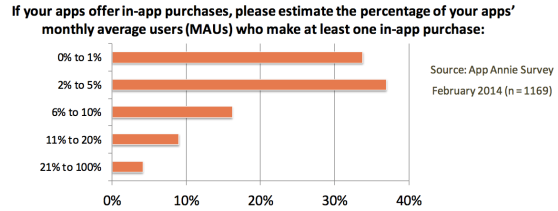If you are developing a mobile app and you are not planning to include in app purchases as part of your revenue model, you might want to think again. As of early 2014 in app purchases represented 79% of all mobile app revenue for iOS according to Distimo. In this article I want to outline how to build a projected revenue model for a mobile app that relies on in app purchases.
I have also created a free Excel template with an In App Purchase Revenue Model that you can download to go along with this post.
Step 1: Estimate # of App Downloads per Month
This is pretty difficult to predict. The number of downloads that your app will get is a function of a few inputs:
- The size of your market
- The size of your current audience or # of website visitors
- The size of your marketing budget. You can always buy downloads through marketing but it can be expensive
- The number of downloads of competing apps – you can find this data from App Annie.
You will have to just make your best guess based on these data points and inputs.
Step 2: Forecast the % of Downloads that Turn into Active Users
Most of the people that download your app will never return after downloading it. Localytics has some good data on the % of users that download your app that will turn into active users. They estimate that 34% of users will return 11 times or more after downloading. This should give you a good point of reference to use as a starting point for your estimate here.
Step 3: Estimate the % of Active Users that Make In App Purchases
Now that you know how many of your downloads will turn into active users, now you need to estimate the number of active users that will make in app purchases. Again this will likely be a very low percentage. The following graph from App Annie should give you a reference point to estimate this number. It will likely be well below 10% as seen below:
Step 4: Project Average $ Amount per In App Purchase
According to an article by Founderspace 71% of in app purchases are under $10. You may also look at your competitors pricing to get an idea of what price you can charge for in app purchases.
Step 5: Project the # of In App Purchases per Month per Active User
This is an important number to get right as well, but it is going to be difficult to find great data here. This is probably just something you will need to refine over time as you see how your users react. Make your best guess based on your app use case.
There you have it. That is the basic process for projecting revenue for a mobile app that relies on in app purchases as a revenue model. Now that you have your revenue projected, you can complete a full set of financial projections using ProjectionHub.

Leave a Reply